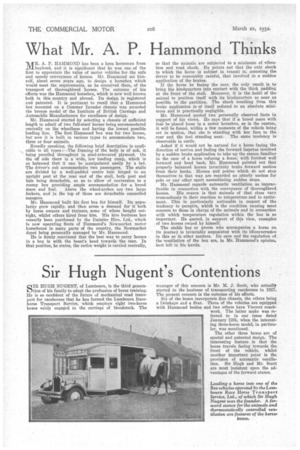Sir Hugh Nugent's Contentions
Page 52

Page 53

If you've noticed an error in this article please click here to report it so we can fix it.
OIR HUGH NUGENT, of Lambourn, is the third generaAi don of his family to adopt the profession of horse training. He is so confident of the future of mechanical road transport for racehorses that he has formed the Lambourn Racehorse Transport Service, which employs eight two-horse boxes solely engaged in the carriage of Woodstock. The
manager of this concern is Mr. M. J. Scott, who actually started in the business of transporting racehorses in 1927. The present concern is the outcome of his efforts.
Six of the boxes incorporate Reo chassis, the others being a Delahaye and a Star. Three of the vehicles are equipped with Hammond bodies and two others have Vincent coachwork. The latter make was referred to in our issue dated January 12th, when the interesting three-horse model, in particular, was mentioned.
The other three boxes are of special and patented design. The interesting feature is that the horse travels facing towards the front of the vehicle, whilst another important point is the provision of automatic ventilation. Sir Hugh and Mr. Scott are most insistent upon the advantages of the forward stance. One of their arguments in that a horse thus placed is well able to resist the effects of a sudden application of the brakes, for he would do so by using his forelegs, as he does when refusing a jump. Another is that when a horse faces backwards his forelegs and his bead are immediately over the rear axle, where vibration is at a maximum.
There is not, in the opinion of these experts, any argument against carrying a horse with its head forward. It involves the use of a long-wheelbase chassis, but that, they state, has, in practice, proved to be an advantage, because of the easier riding qualities which it gives to the vehicle gen orally.
The ventilation system is most interesting. Fresh air enters in the front of the vehicle and is conveyed along ducts immediately beneath the roof to thermsstatically controlled .shutters. The adjustable thermostats are mounted in the box and are, therefore, controlled by the heat of the horse. The two stalls are entirely independent, so that the temperature of each is separately controlled.
The grooms' compartment is by the side of the driver's cabin, with a Triplex-glass sliding partition dividing the two compartments. There is large luggage accommodation at ,the rear, whilst the equipment of the vehicle includes an unusually big direction indicator, as well as two spotlights to facilitate loading and unloading in the dark. The illuminated name plate is of practical value, and has already, on more than one occasion, facilitated getting in touch with the driver, in order to divert him from the first-arranged route.
The sole coneessiennaire for the box is Willson Commercial Motor Body Builders (Kingston), Ltd., High Street, Kingston-on-Thames. It is sold as a " luxury" type for £500, and, in a less elaborate form, but including, of course, the features of forward location of the horse and automatic ventilation, for £375.
In the foregoing article we have been able to put forward the opinions of two well-known authorities in the transport of horses. We shall be pleased to learn the views of other experienced persons and, where thought advisable, to publish them in these columns.




































































































